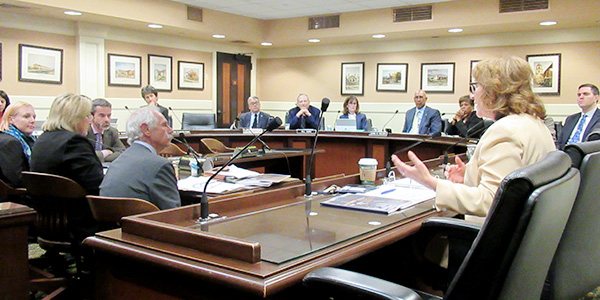By Hudson Sangree
SACRAMENTO, Calif. — Public Utilities Commission President Michael Picker told lawmakers Wednesday the commission probably isn’t the best public entity to address the “enormity” of the state’s recent wildfire crisis.
The PUC has been trying to help prevent wildfires sparked by electric utilities, as required by last year’s SB 901. But the commission, Picker said, is more like a specialized court that sets utility rates, not a fire prevention agency such as the Department of Forestry and Fire Protection.
“They understand fires. We understand ratemaking,” Picker told the Assembly Utilities and Energy Committee during its annual oversight hearing of the PUC.
He said the commission was set up long ago to slowly gather and weigh evidence on regulated utilities, not to react quickly to urgent public safety matters.
“I don’t think this is where you’re going to get a sense of urgency,” Picker said later.
Picker’s briefing on the PUC’s varied activities quickly turned into a sometimes tense discussion of wildfires and Pacific Gas and Electric, which filed for bankruptcy Tuesday. (See PG&E Files for Bankruptcy.) Some lawmakers were cordial with Picker, while others grilled him about what the commission was doing to prevent more devastating wildfires like the deadly ones that ravaged the Northern California in the past two years.
“We’re well over 100 deaths in these fires,” said Assemblymember Jim Wood (D), whose North Coast district was heavily scarred by the wine country wildfires of 2017. “What will you do this year to protect Californians?”
Picker said the PUC had been in the process of figuring out what to do with PG&E, including breaking up the company or replacing its board members.
Financial penalties, including a $1.6 billion fine after the San Bruno gas line explosion in 2010, had failed to change the company’s board members or safety culture, he said.
“Fines are just not enough,” Picker said.
Now those decisions likely will be made by a federal bankruptcy judge, with the PUC recommending a reorganization plan for PG&E, he said.
“We will contend with them as advocates for ratepayers in bankruptcy,” Picker said.
Earlier this month, a federal judge overseeing PG&E’s criminal probation in the San Bruno case said he might require the utility to inspect every inch of its grid before the 2019 fire season starts this summer. The judge backed off on that plan, at least temporarily, in a hearing in San Francisco earlier Wednesday. (See Judge Postpones Strict Probation Conditions for PG&E.)
Picker said the PUC had looked at what it would take for it to inspect the state’s high-risk fire areas for overhanging branches and other safety problems. He said the commission would need to hire between 15,000 and 20,000 workers to inspect 4.2 million power poles and 200,000 miles of transmission lines.
A better investment, he said, would be for utilities to adopt extensive weather monitoring, as San Diego Gas & Electric did in Southern California. The National Weather Service typically estimates wind gusts on ridgetops. Fires start near electric lines in canyons down below. SDG&E deployed an extensive network of weather stations and cameras in such locations, Picker said. (See Calif. Regulators to Scrutinize De-energization.)
“They had to develop a whole new weather system within their service area,” and PG&E could do the same in Northern California, he told committee members.
Assemblyman Bill Quirk (D) suggested the PUC had been partly responsible for driving PG&E into bankruptcy. SB 901 tasked the commission with performing a stress test to determine how much a utility could pay in wildfire liability without harming ratepayers or undermining grid reliability. The rest would have to be paid by shareholders.
Creditors wanted to know the extent of PG&E’s expected liability, Quirk said. The utility must borrow $2 billion a year, and the PUC’s inability to provide creditors with more certainty had led major ratings firms to downgrade PG&E’s creditworthiness to junk status and cut off its access to credit, he said.
Picker said the PUC couldn’t supply a stress-test figure until all official fire investigations have concluded and it performs its own analysis, which could take 18 months. “We don’t know the cost in the end,” he said.




